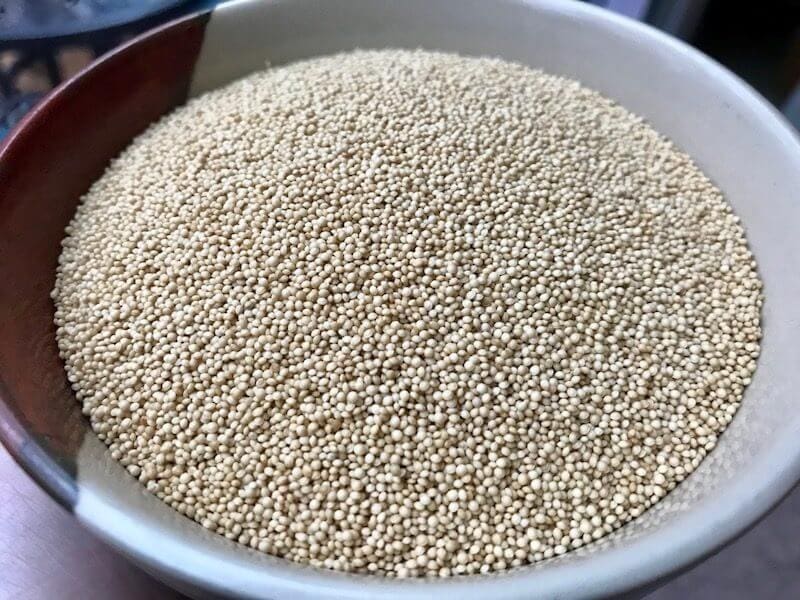
All About Amaranth
By Chef Sara
If you thought quinoa was tiny and cute, wait until you meet amaranth! This pseudo-grain (a seed that’s used the same way as a grain) is even smaller than quinoa – but what it lacks in size, it makes up for in great nutrition and a pleasant, nutty flavor. Unlike quinoa, though, amaranth cooks up into a thick, almost sticky texture that may be off-putting if you’re expecting a light, fluffy side dish. Don’t let that scare you off, though! Amaranth is a natural fit for stellar breakfast porridges, fillings for stuffed vegetables, and as an add-in to soups and stews. And if you dry-toast a bit of uncooked amaranth in a skillet, you end up with adorable amaranth “popcorn”. Pretty nifty! If you’re looking to change up your grain game, here are five reasons why amaranth deserves a place of pride in your kitchen – plus some great recipes to try!
#1 Amaranth is high in protein – even higher than quinoa! There are 9 grams of protein in 1 cup cooked amaranth, as compared to 8 grams in a cup of quinoa. As a comparison,1 egg contains 6 grams of protein. With protein-packed plant foods like amaranth readily available, you’ll never need to worry about where you’ll be getting your protein on a vegan diet.
#2 Amaranth is high in fiber. High-fiber foods support heart health, help reduce the risk of Type-2 Diabetes, nourish beneficial gut bacteria, and help you feel fuller longer. That’s a lot of wins for a humble little grain!
#3 Amaranth is naturally gluten-free. If you or someone you love suffers from Celiac disease or a gluten sensitivity, amaranth is a safe choice. As with all grains, double check that the amaranth you’re purchasing is certified gluten-free if you’re especially sensitive to potential cross-contamination.
#4 Amaranth is rich in important nutrients – especially calcium and iron. One cup of cooked amaranth contains 31% of the average adult’s recommended daily intake (RDI) of calcium and 82% of the RDI of iron. Clearly, meat and dairy aren’t the only sources for these valuable nutrients.
#5 Amaranth lends itself to both sweet and savory preparations. For breakfast inspiration, try our Amaranth Breakfast Porridge with Blueberries and Hemp Seeds. For lunch or dinner, you’ll love our Lentil, Amaranth, and Walnut Portobellos.
If you’re looking to change up your grain game, here are five reasons why amaranth deserves a place of pride in your kitchen – plus some great recipes to try!
#1 Amaranth is high in protein – even higher than quinoa! There are 9 grams of protein in 1 cup cooked amaranth, as compared to 8 grams in a cup of quinoa. As a comparison,1 egg contains 6 grams of protein. With protein-packed plant foods like amaranth readily available, you’ll never need to worry about where you’ll be getting your protein on a vegan diet.
#2 Amaranth is high in fiber. High-fiber foods support heart health, help reduce the risk of Type-2 Diabetes, nourish beneficial gut bacteria, and help you feel fuller longer. That’s a lot of wins for a humble little grain!
#3 Amaranth is naturally gluten-free. If you or someone you love suffers from Celiac disease or a gluten sensitivity, amaranth is a safe choice. As with all grains, double check that the amaranth you’re purchasing is certified gluten-free if you’re especially sensitive to potential cross-contamination.
#4 Amaranth is rich in important nutrients – especially calcium and iron. One cup of cooked amaranth contains 31% of the average adult’s recommended daily intake (RDI) of calcium and 82% of the RDI of iron. Clearly, meat and dairy aren’t the only sources for these valuable nutrients.
#5 Amaranth lends itself to both sweet and savory preparations. For breakfast inspiration, try our Amaranth Breakfast Porridge with Blueberries and Hemp Seeds. For lunch or dinner, you’ll love our Lentil, Amaranth, and Walnut Portobellos.

 We hope you’ll give amaranth a try. Please let us know how it goes for you, and happy cooking!
We hope you’ll give amaranth a try. Please let us know how it goes for you, and happy cooking!
amaranth, cooking vegan food, vegan, vegan cooking, vegan food, vegan recipes
Comments are closed.






Nicely done. I am sold. Gonna up my “grain game.” Appreciate the facts about calcium and iron. Powerhouse, eh? Nifty indeed. Thx Chef!
Thanks for the reminder about amaranth. It is easy to forget for some reason. I think you may have missed linking to the porridge recipe and the other recipe uses cooked amaranth. I’ve never done anything with it but “popping” it. Do you treat it like quinoa or is it cooked differently, somehow?